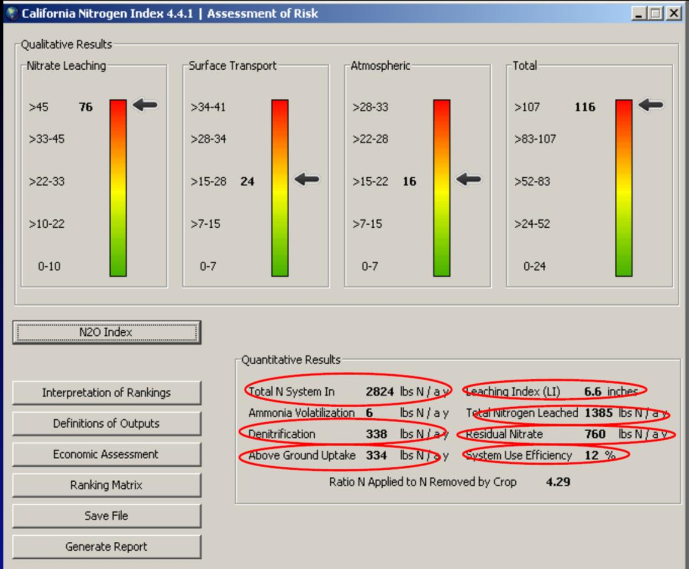A couple of weeks ago I had the privilege of spending a couple of hours with Dr. Jorge Delgado at his office in Fort Collins, Colorado. Dr. Delgado is a research soil scientist with USDA’s Agricultural Research Service (ARS) and one of the godfathers of Precision Conservation. While visiting, Dr. Delgado demonstrated his Nitrogen Index tool. The Nitrogen Index tool is designed to help resource professionals quickly assess the N loss risk related to agricultural nitrogen. Currently, there are several nitrogen tools available through the private sector that help farmers more precisely predict the amount of nitrogen required to produce a crop. These tools are great from a production standpoint, but do little to help evaluate the environmental impacts of nitrogen fertilizer. Dr. Delgado’s Nitrogen Index tool is the first tool that I have seen that provides information on the level of nitrogen lost from a crop system. It shows the other side of the production equation.
The Nitrogen Index is a parallel to the Phosphorus Index (PI) as a relative risk assessment tool that provides field guidance for determining the potential movement of nitrogen in the landscape. The Nitrogen Index can consistently and systematically make assessments over various landscapes and cropping systems. This relative assessment provides an index number (not load or concentration) where higher scores indicate a greater risk for N movement.
Nitrogen Index loss pathways include:
- surface transport of nitrogen via runoff and erosion
- atmospheric losses due to denitrification and ammonia volatilization
- nitrate leaching losses
Each one of the loss pathways is assessed separately. The score of the separate assessments can be used to determine the severity of natural resource concerns and to develop mitigation strategies for conservation practices and management techniques. Individual movement risk category scores rated as “high” would provide categorical targets for further review or mitigation.

Site characteristics include soil factors, hydrology factors, climate factors, N management factor, sink factors, and crop management (conservation practices). Site characteristics would be readily available. (Delgado and Follett., 2010)
If we in agriculture are going to take nitrogen management seriously then we need to pay as much attention to nitrogen losses as we do to the crop needs of nitrogen.
Note: The Nitrogen Index is free to use by anyone. If anyone is interested in trying the tool(s) they can download the tools from:
- Windows Desktop tools: http://www.ars.usda.gov/npa/spnr/nitrogentools
- Android Nitrogen Index 4.4: https://play.google.com/store/apps/details?id=gov.usda.ars.spnr.driver
Sources: Delgado, J.A., and R.F. Follett, eds. 2010. “Advances in Nitrogen Management for Water Quality.” Ankeny, IA: Soil and Water Conservation Society.

Tom, great resource you’ve provided and the first time I’ve been aware of something of this nature. Thanks for sharing
Tom, I need to correct you on your statement that the current tools do not evaluate environmental impacts. Adapt-N not only provides adaptive nitrogen rate recommendations, but also offers explicit estimates of nitrate leaching losses, denitrification losses, and shortly also nitrous oxide losses.